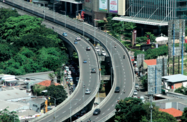Strong growth in the domestic and foreign travel market, combined with a commitment to boosting capacity as part of large-scale transport infrastructure development, is driving investment in Indonesia’s aviation sector.

On February 21, Garuda Indonesia, the national carrier, announced plans to issue bonds with a combined value of $500m on the international market.
Pahala Mansury, Garuda’s president-director, told media that the airline would also be tapping the foreign financial markets for $100m.
While some of the money raised will be used to pay down old debt, the carrier is looking to fund expansion on both domestic and international routes.
An improved outlook has bolstered Garuda’s plans for growth, with the company forecasting earnings of $4.9bn this year – up from an estimated $4bn in 2017 – and a year-end profit of $8.9m. By comparison, losses of $222m were recorded in the first three quarters of last year.
An anticipated 11% jump in passenger numbers to more than 26.6m this year should help drive this turnaround.
Rising passenger numbers on domestic and international flights
A sharp increase in passengers was seen throughout Indonesia’s commercial aviation sector in the first three quarters of 2017, when the number of international air travellers increased by 14.5% year-on-year (y-o-y) to 12.5m, with forecasts suggesting the full-year figure for 2018 could reach 17m.
Domestic traffic also grew over the period, with internal air passengers totalling 66m, up 11.3% y-o-y, according to data from the Central Statistics Agency. The Indonesia National Air Carriers Association forecasts passenger growth of 12% in 2018.
This combination of rising visitor numbers and high volumes of internal passengers has helped Indonesia to become one of the world’s fastest-growing air travel markets, a position it is set to cement over the coming decades, according to a report by the International Air Transport Association. Its findings from early 2017 suggest the country will be the fourth fastest growing market in terms of additional passengers per year through to 2035, when 242m air travellers are expected.
Most will be domestic travellers, with growth expected to be fuelled by higher income levels and access to a broader range of destinations on the back of an increase in the number of aviation hubs in operation.
Expansion under way at Soekarno-Hatta International Airport
Acknowledging this rise in demand, efforts to expand Soekarno-Hatta International Airport (SHIA), the country’s main aviation facility, are ongoing. In February it was reported that progress was made with land acquisition required for a third runway. According to a statement from state airport operator Angkasa Pura II, 100 ha of land would be acquired, with construction to start soon afterwards.
Authorities expect the runway to be completed in 18 months, bringing the airport’s handling capacity from 81 to 114 plane movements per hour.
Angkasa Pura II’s broader expansion plans for the next five years are expected to cost a total of Rp94.9trn ($6.9bn), with most of this to be channelled into SHIA and airports in Sumatra.
The airport operator also has plans in the pipeline to build a fourth terminal at SHIA, which it expects to be ready by 2022, and to revamp terminals one and two by 2020.
Seven new airports have opened in Indonesia since 2014, with another new hub, Kertajati International Airport, scheduled to begin operating in June. Located in West Java, the facility will have the capacity to accommodate 2.7m passengers annually.
Train links to facilitate journeys taking shape
Alongside efforts to accommodate rising air passenger numbers, moves to strengthen broader transport links are also gaining pace, including the construction of rail lines that will provide travellers with train services to and from key airports.
Two rail links – a 26-km line between Minangkabau Airport and Padang in West Sumatra and the Palembang Light Rail Transit project linking Sultan Mahmud Badarudin II Airport to Ogan Permata Indah in the South Sumatran capital of Palembang – are scheduled to begin running in in the first half of this year.
In early January, a proposal was made to extend the planned 140-km high-speed railway between Jakarta and Badung to 200 km, with the government looking to add links to SHIA and the under-construction Ketajati Airport.
However, the original rail plan has hit delays since construction started in 2016 and is unlikely to launch services by 2019 as planned.


